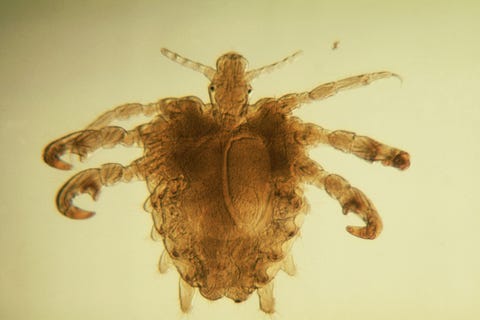How to Get Rid of Head Lice Eggs for Good
Dealing with lice on any part of your body sounds incredibly freaky. But finding lice on your eyelashes? That just might be something out of a horror movie.
For the record: Yes, it's possible to get lice on your eyelashes. While it's not common, it definitely happens. "I have seen several cases," says Gary Goldenberg, M.D., assistant clinical professor of dermatology at the Icahn School of Medicine at Mount Sinai in New York City.
Whether you think you might have eyelash lice, or you just have a total fascination with freaky health phenomena, here's what you should know about what they look like and how to get rid of them for good.
Back up: Are eyelash lice the same as head lice?
Actually, no. There are three types of lice that live on humans, according to the Centers for Disease Control and Prevention (CDC):
- Pediculus humanus capitis (a.k.a. head lice)
- Pediculus humanus corporis (body lice or clothes lice)
- Pthirus pubis ("crabs" or pubic lice)
Eyelash lice actually stem from pubic lice, explains Joshua Zeichner, M.D., a New York City board-certified dermatologist. "Pubic lice have evolved to attach to coarse hair in the genital area, but it also can attach to hair in the eyebrows and the eyelashes," he says.
In general, public lice "like shorter hair," Dr. Goldenberg says. The CDC says this form of lice can also show up in beard, mustache, chest, or armpit hair.
So, what causes pubic lice on your eyelashes?
A case of eyelash lice is usually caused by "extended contact" with someone who has pubic lice, Dr. Zeichner says. It can happen after intimate contact, and occasionally after personal contact with clothing, bed linens, or towels that were used by an infested person. It can also happen when people touch their genitals and then their eyes.
And before you freak out about public restrooms here, know it is "extremely rare" for pubic lice to infest a person after sitting on a toilet seat, as critters cannot survive away from a human body and don't have feet that allow them to move around smooth surfaces, the CDC says.
⚠️ If you find pubic lice on a child, seek help from a doctor or trusted professional ASAP. It may actually be a sign of sexual contact or abuse.
What do eyelash lice look like?
Adult pubic lice are between 1.1 to 1.8 millimeters in length, the CDC says. Like head lice, they have three stages:
- Nits: These are lice eggs, and they usually attach firmly to hair shafts (or eyelashes). They're typically oval and yellow or white.
- Nymphs: Nymphs are immature pubic lice that hatch from the nit. To live, they need to feed on your blood.
- Adults: Adult pubic lice look like a mini crab. They have six legs, with two large front legs that look like a crab's pincher claws. They're tan to grey-ish white in color. They also need to feed on human blood.

London Scientific Films Getty Images
What are the symptoms of eyelash lice?
In general, you'll have itching around your eyelashes or eyelids, along with visible nits on your lashes, the CDC says. You might also actually see live lice crawling around.
How to get rid of lice on your eyelashes
Getting rid of eyelash lice depends on a variety of factors. "If there is a small number of lice, they physically can be removed," Dr. Zeichner says. You can also try combing ophthalmic-grade petrolatum ointment (which is only available by prescription) to the eyelid margins two to four times a day for 10 days, the CDC says. Note: You don't want to use regular petrolatum like Vaseline—it can irritate your eyes.
If that doesn't do the trick, Dr. Goldenberg says that your doctor may recommend an oral anti-parasite medication called ivermectin.
Bottom line: Finding lice on your eyelashes is not something to sit on, and seeing a doctor will be your best bet in getting rid of the problem. "Lice should be treated as soon as possible to prevent spreading to other areas of the body or other people," Dr. Goldenberg says.
Like what you just read? You'll love our magazine! Go here to subscribe. Don't miss a thing by downloading Apple News here and following Prevention. Oh, and we're on Instagram too .
Korin Miller Korin Miller is a freelance writer specializing in general wellness, sexual health and relationships, and lifestyle trends, with work appearing in Men's Health, Women's Health, Self, Glamour, and more.
This content is created and maintained by a third party, and imported onto this page to help users provide their email addresses. You may be able to find more information about this and similar content at piano.io
How to Get Rid of Head Lice Eggs for Good
Source: https://www.prevention.com/health/a29551102/eyelash-lice-causes/